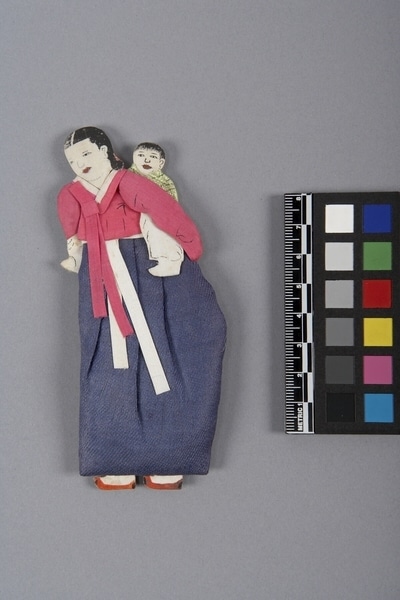Doll Item Number: Ed1.115 from the MOA: University of British Columbia

Description
Figure representing a woman holding a baby her back on a flat backing of white paper. Front view is depicted of figure which is made of lightly padded cloth to give a three-dimensional effect having each portion made of a separate piece of cloth with painted details. Baby is wearing a light green shirt, and white trousers. Woman is wearing a short light red-pink cotton blouse tied with the same colour ribbon on the right side, an ankle-length purple cotton skirt fastened under the arms with a ribbon of the same colour, white socks, and low orange shoes. Two pieces of white flannel hemmed in light red-pink silk are sewed to the paper backing.
History Of Use
Figures represent woman and baby of late 19th to early 20th century. The woman's hairstyle (bun at nape of neck) indicates that she is married. Babies are commonly carried this way. Such figures were made during the time when Korea was first open to the outside world (after the mid 1890s), probably as gifts to present to missionaries or other visitors from foreign countries. Flat dolls like these were very popular during the period 1910-20. Before that time, shamans made dolls that they sold to their clients, as images of those the clients wanted to exorcise. Simple dolls were made of straw for children to play with. After Korea opened, people began to see dolls as artistic objects. They were made in workshops by masters, using authentic fabrics whenever possible, as their purpose was to introduce foreigners to Korean society. An ordinary woman who had a baby, especially if the baby was a son, would not have to work outdoors but could remain in the house and wear clothes of better quality. Young children who were not yet toilet trained wore cotton trousers, which were more easily cleaned.
Iconographic Meaning: The clothes on this figure show that she is of ordinary class, but has high status in the household because she has given birth to a child, and especially because the baby is a son. Her clothing is more colourful than that of more ordinary women, her skirt is longer, and she wears better shoes, with patterns.
Narrative
Collected by J. H. Morris while he was chief engineer for Seoul Railway, Korea.
Specific Techniques
The clothing was stitched around the edge and then a layer was added inside the clothing. Each section was separately applied and pasted in place. The details were finely painted.
Item History
- Made in Korea during 1910
- Collected between 1910 and 1939
- Owned by Marion Stephan before August 1964
- Received from Marion Stephan (Donor) during August 1964
What
- Name
- Doll
- Identification Number
- Ed1.115
- Type of Item
- doll
- Material
- paper, silk fibre, cotton fibre, rayon fibre ?, paint and adhesive
- Manufacturing Technique
- spun, woven, cut, painted, sewn and pasted
- Overall
- height 12.3 cm, width 5.2 cm, depth 1.1 cm
Who
- Culture
- Korean
- Previous Owner
- Marion Stephan
- Received from
- Marion Stephan (Donor)
Where
- Holding Institution
- MOA: University of British Columbia
- Made in
- Korea
When
- Creation Date
- during 1910
- Collection Date
- between 1910 and 1939
- Ownership Date
- before August 1964
- Acquisition Date
- during August 1964
Other
- Condition
- good
- Current Location
- Case 77
- Accession Number
- 0113/0018